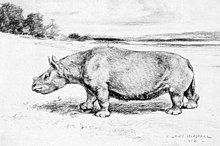Our website is made possible by displaying online advertisements to our visitors.
Please consider supporting us by disabling your ad blocker.
Teleoceras
| Teleoceras | |
|---|---|

| |
| Specimen at the Natural History Museum of LA | |

| |
| 1913 T. fossiger illustration by Robert Bruce Horsfall. | |
| Scientific classification | |
| Domain: | Eukaryota |
| Kingdom: | Animalia |
| Phylum: | Chordata |
| Class: | Mammalia |
| Order: | Perissodactyla |
| Family: | Rhinocerotidae |
| Subfamily: | †Aceratheriinae |
| Genus: | †Teleoceras Hatcher, 1894 |
| Type species | |
| †Teleoceras major | |
| Species[1] | |
| |
| Synonyms | |
Teleoceras (Greek: "perfect" (teleos), "horn" (keratos)[4]) is an extinct genus of rhinocerotid. It lived in North America during the Miocene and Pliocene epochs during the Hemingfordian to the end of Hemphillian from around 17.5 to 4.9 million years ago.[5][6] It grew up to lengths of 13 feet (4.0 meters) long.[7]
Teleoceras went extinct in North America alongside Aphelops at the end of the Hemphillian, most likely due to rapid climate cooling, increased seasonality and expansion of C4 grasses, as isotopic evidence suggests that the uptake of C4 plants was far less than that in contemporary horses.[6] The Gray Fossil Site in northeast Tennessee, dated to 4.5-5 million years ago, hosts one of the latest-known populations of Teleoceras, Teleoceras aepysoma.[8]
- ^ Prothero, 2005, p. 94.
- ^ McKenna & Bell, 1997, p. 483.
- ^ Prothero, 2005, p. 122.
- ^ "Glossary. American Museum of Natural History". Archived from the original on 20 November 2021.
- ^ (Prothero, 2005)
- ^ a b Wang, B.; Secord, R. (2020). "Paleoecology of Aphelops and Teleoceras (Rhinocerotidae) through an interval of changing climate and vegetation in the Neogene of the Great Plains, central United States". Palaeogeography, Palaeoclimatology, Palaeoecology. 542: 109411. Bibcode:2020PPP...54209411W. doi:10.1016/j.palaeo.2019.109411.
- ^ "Region 4: The Great Plains". geology.teacherfriendlyguide.org. Retrieved 2021-06-26.
- ^ Short, Rachel A; Wallace, Steven C. "A New Species of Teleoceras (Mammalia, Rhinocerotidae) from the Late Hemphillian of Tennessee".
{{cite journal}}: Cite journal requires|journal=(help)
Previous Page Next Page


